The determination of virtual source position using convergent anti-trigonometric functions (arcCOSan
The determination of virtual source position using convergent anti-trigonometric functions (arcCOSand arcSIN) method for scanning-passive scatter beam in carbon ion therapy
Yan-Cheng YE1,ADE,#, Wen-Hua ZHANG1,BD*, Jian WANG1,BCE,#, Yan-Shan ZHANG1,*, Jia-Ming WUID1,2,3,ABCDEF,*
1Heavy Ion Center of Wuwei Cancer Hospital; Gansu Wuwei Academy of Medical Sciences, Hepatic Diseases Center; Gansu Wuwei Tumor Hospital, Wuwei city, Gansu province, China.
2Department of Medical Physics, Chengde Medical University, Chengde City, Hebei Province, China.
3Department of Radiation Oncology, Yee Zen General Hospital, Tao Yuan City, Taiwan.
#Co-first authors with equal contribution: Yan-Cheng Ye, Jian Wang
*Corresponding authors with equal contributions: Wen-Hua Zhang; 13830510999@163.com, Jia-Ming Wu; jiaming.wu@chmsc.com
(received 8 August 2022; revised 26 October 2022; accepted 5 January 2023)
Abstract
Introduction: We developed a convergent trigonometric functions technique (arcCOS, arcSIN) capable of dealing with the virtual source position delivered by different carbon ion energies from the pattern of scanning-passive scatter beam in this study.
Materials and Methods: A home-made large-format CMOS sensor and Gaf Chromic EBT3 films were used for the virtual source position measurement. The Gaf films were embedded in a self-designed rectangular plastic frame to tighten the films and set up on a treatment couch for irradiation in the air with the film perpendicular to the carbon ion beam at the nominal source-axis-distance (SAD) as well as upstream and downstream from the SAD. The horizontal carbon ion beam with 5 energies at a machine opening field size was carried out in this study. The virtual source position was determined with a convergent arcCOS and arcSIN methods and compared with the linear regression by back-projecting the FWHM to zero at a distance upstream from the various source-film-distance.
Results: The film FWHM measurement error of 0.5 mm (the large-format CMOS detectors was in pixel, a pixel equals 0.5 mm) leads to 1×10⁻³% deviation of α(cACOS and cASIN) at every assumed virtual source position. The overall uncertainty for the reproducibility of the calculated virtual source position by the assumed t in the vertical and horizontal directions amounts to 0.1%. The errors of calculated virtual source position by assumed t with back projecting FWHM to zero methods were within 1.1 ± 0.001, p = 0.033. The distance of virtual source positions is decreased from SAD with high to low energy.
Conclusion: We have developed a technique capable of dealing with the virtual source position with a convergent arcCOS and arcSIN methods to avoid any manual measurement mistakes in scanning-passive scatter carbon ion beam. The method for investigating the virtual source position in the carbon ion beam in this study can also be used for external electrons and the proton.
Keywords: carbon ion beams; virtual source position; convergent arcCOS, arcSIN; scanning-passive scatter beam.
Introduction
The carbon ion beam, unlike an electron beam from a linear accelerator, does not emanate from a physical point source in the nozzle acceleration system.¹⁻⁴ A narrow energy-dependent spot size of the carbon ion beam, after passing through the horizontal and vertical scanning magnets in the vacuum window of the accelerator, primary collimator, beam monitor, spreading-scatterer, ridge filter and ridge shifter, and range shifter, is scanned spreading into a broader two-dimensional field that appears to diverge from a point. This point is known as the virtual source position,⁵ which may be defined as an intersection point of the back projection along with the most probable directions of carbon ions motion at a fixed position, for example, on the plane at a nominal source-axis-distance. There are many investigations describing the method of determining the virtual-source position by inverse square law correction for output at extended SSDs under all clinical conditions or by field size magnification on film with distance.⁶⁻⁹ Despite a lot of methods that have been proposed for the determination of virtual source position for electron beam therapy in a linear accelerator, none for heavy charged particles-like carbon ions and proton beams have been investigated.¹⁰⁻¹¹ Usually, the virtual source point needs to be measured by the back-projection of the 50% width of the beam profiles acquired at different distances upstream or downstream of the source in external electron therapy.¹² In our facility, a certain beam field size without the collimation of multi-leaves collimator (MLC), the largest field size was used for measurements in this study. The measurement of virtual source position for carbon ion beams was unusual than in electron beam therapy, the measurement of virtual source position cannot apply by inverse square law correction from chamber output at extended SSDs since no inverse square response is available for the chamber along the carbon beam's percent depth dose curve on the plateau at different distances.
The Institute of Modern Physics (IMP) was founded in 1957 in Lanzhou, China. The National Laboratory of Heavy Ion Accelerator, Lanzhou (NLHIAL) was established at IMP in 1991 to take advantage of the full usage of the research facilities at IMP.⁸ WuWei Heavy Ion Center, Wuwei Cancer Hospital, GanSu, China (WHICH) consists main synchrotron ring to accelerate sufficient particle energy and flux for four treatment rooms used- room 2, equipped with a horizontal, and a vertical nozzle aimed at one isocenter with scanning-passive scatter beam, was adopted for the virtual source position study. The importance of the virtual source position not only fits the need of correcting the opening of the multi-leaf collimator in field sizes but also supports the fabrication of compensators for carbon ion therapy for the patient-specific dosimetric calculation in the treatment planning system.
The virtual source position for carbon ion beams of energies 120, 190, 260, 330 MeV/u, and 400 MeV/u in the WHICH have been measured. It is realized that the virtual source position's issue in the electron beam is highly energy-dependent, therefore, if the issue is also highly energy and field size-dependent for the carbon ion beam then the virtual source position needs to be measured carefully for each nozzle.
The virtual source position was intended to be determined with the conventional back projecting zero method and was double-checked additionally by the convergent arcCOS method to minimize mistakes caused by manual measurement by exposing a certain field on CMOS sensor and films in the air with an interval of some distance upstream and downstream from nominal source-axis distances for beam profiles analysis.
The dosimetric characteristics of step-by-step Linear Energy Transfer (LET) inside the human body of carbon ion passive-scatter beams generated by IMP cyclotron-synchrotron accelerators depend on the horizontal and vertical scanning magnets in the vacuum window of the accelerator, primary collimator, beam monitor, spreading scatterer, ridge filter, and ridge shifter, and range shifter. For the majority of clinical situations, not only the LET for dose calculation but also the field size opened by the Multi-Leaf Collimator of passive-scatter design was influenced significantly by the virtual source position in carbon ion beams. This study is to remedy a defect of no investigation for the virtual source position of the carbon ions beam.
Materials and Methods
A horizontal beam equipped in room 2 was adopted for the effective source position measurement in this study, the construction and physical geometry dimension of our carbon ion facility is shown in Figure 1. The carbon ion beam passes a horizontal magnet scanning at the x-direction beam first, and then through to a vertical magnet scanning at the y-direction beam to create the scanned x-y field size for clinical use. The ridge filter, ridge shifter, and range shifter, as well as compensator, were removed with only the primary collimator opened during the measurement in this study. The carbon ion with an initial energy of 120 MeV/u to 400 MeV/u in an increasing interval of 70 MeV/u and field sizes set by the horizontal-vertical magnets at a machine opening field size was carried out for the measurements of the virtual source position at our institute in this study. The distance between the 50% of the central axis value from the profiles was measured and denoted as the full-width half maximum (FWHM). The FWHM was measured and plotted as a reciprocal profile using the measurement of the machine opening field with different distances measured upstream or downstream within 50 cm from the SAD.

The linear relationship of the beam's FWHM in the air appears to diverge geometrically from a point source where the beam width is 0 when projecting these lines back to the central axis. On the contrary, the angle of arcCOS and arcSIN at each different field size and its relative virtual source position converges to one unique value when an exact assumed virtual source position is given. The virtual source position using the convergent arcCOS/arcSIN methods can be used to double check with the back projecting zero methods to avoid any manual measurement mistakes in the scanning-passive scatter carbon ion beam.
Experiment setup in the treatment room
In this study, an IMP home-made large-format OmniVision (Shanghai, China) model OV9712 and Aptina (ON Semiconductor, Phoenix, AZ, USA) model AR0130 COTS CMOS active pixel sensors (APSs) were used as an FWHM detector for measurement in carbon scanning-passive scatter beam measurement. The CMOS COTS digital sensors are energy independent and can be used for particle counting up to a radiation dosage of 51.24 Gy after good calibration of linearity and reproducibility to reduce background noise.¹³,¹⁴ The large-format CMOS sensor was set up on the treatment couch in the air with the detector's perpendicular face to the carbon ion beam at the nominal source-axis-distance (SAD) as well as upstream at 20 cm, 40 cm, and 50 cm and downstream at 10.4 cm from the SAD in Figure 1.
Gaf Chromic EBT3 films were used to double checking with CMOS profiles. Gaf Chromic EBT3 films were embedded in a self-designed rectangular plastic frame to tight the films and set up on the treatment couch in the air with the film perpendicular to the carbon ion beam at the nominal source-axis-distance (SAD) as well as upstream and downstream 20 cm from the SAD in Figure 1. Both the measurement of CMOS and the Gaf Chromic EBT3 film in a horizontal carbon ion beam with 5 energies at a maximum field size of 231.875 mm × 234.827 mm for the measurements of virtual source position were carried out in this study.
The FWHM measurement with the CMOS sensor and the GAF EBT 3 film
The large-format CMOS sensor was placed on the treatment couch with the detector's frontal face to the horizontal nozzle, corresponding to the beam entering from the top (front face) of the detector. All five energy of carbon ion beams could be evaluated during this investigation. The large-format CMOS signals were in pixels, and the Gaf Chromic EBT3 films (Ashland Specialty Ingredients GP, NJ USA; Lot # 04022002, Exp. Date: April 2023) was adopted for the dose profile measurement in determining the virtual source position for this study. The dose profile of the exposed film was processed following international protocols.¹⁵ Films were conducted with a pre-exposure technique to reduce the uncertainty in deriving the calibration curve.¹⁶
Derivation of horizontal and vertical magnets driven dose profiles to get the FWHM
The FWHM of dose profiles measured by the large-format CMOS detectors were mainly adopted for the virtual source position study. All exposed films of the desired field size were then scanned with an Epson Expression 11000XL scanner in the 72 dpi mode (0.353 mm per dot interval), and the data were saved as tagged image file format (TIFF) and analyzed by the filmQA Pro v7 (Ashland, USA) imaging procession software. A red filter was placed on top of the GAF films to raise the resolution of the dose-OD curves before scanning to increase the slope of the H-D curve.¹⁷
Determine the horizontal source position by back-projecting the distance between FWHM for the various source-film-distance
Firstly, plot the FWHM versus nominal distance curves for every SAD, upstream and downstream, based on the film setup geometry in Figure 1. Secondly, derive the linear regression (y=ax+b, y denotes FWHM, x is the virtual source position from the nominal SAD shown in Figure 1) from the curves created by the FWHM versus nominal distance. Thirdly, let y=0, then the virtual source position can be derived from b divided by a. The negative value denotes that the virtual source position is upstream from SAD toward the carbon ion source point.
Determine the horizontal nozzle virtual source position by the convergent arcCOS (cACOS) method at the various source-film-distance
The method of convergent arcCOS (cACOS) was displayed in Figure 2, t denotes the assumed length of the virtual source position from nominal SAD, and FS is the field size at the detector position. This method was based on the angle of arcCOS, α will converge to a unique value in the arcCOS calculation when an assumed virtual source position, t is given to all different upstream of downstream distance. The virtual source position was then calculated by the converged arc COS method with the assumed virtual source position, t, in t at nominal SAD, tupstream with upstream distances at 20 cm, 40 cm, 50 cm, and tdownstream with downstream distances at 10.4 cm.
The calculate the value of α,

the calculation result also stands for the converged angle, α, which can be derived by the arcCOS or arcSIN with a given t upstream or downstream from the position of Source-Axis distance (SAD). Then for each column, for example, ACOS:t+10.4 denoted as the calculation of α at a distance 10.4 cm from downstream the point of nominal SAD (source-axis distance); ACOS:t represents the calculation of α at the distance from the point of nominal SAD (source-axis distance); ACOS:t-20, ACOS:t-40, ACOS:t-50, represents the calculation of α at the distance upstream 20 cm, 40 cm and 50 cm from the point of nominal SAD (source-axis distance), respectively. The calculation of the "least squares errors" is demonstrated as the following equation:

Determine the horizontal nozzle virtual source position by the convergent arcSIN (cASIN) method at the various source-film-distance
The method of convergent arcSIN (cASIN) is displayed in Figure 3; t denotes the assumed length of the virtual source position at the nominal distance from the point of SAD, and FS is the field size at the detector position. This method was based on the angle of arcSIN, α will converge to a unique value in arcSIN calculation when an assumed virtual source position, t is given to all different upstream or downstream distances from the point of SAD. The virtual source position was then calculated by the converged arcSIN method with the assumed virtual source position, t, in t at the nominal distance from the point of SAD, tupstream with upstream distances at 20 cm, 40 cm, 50 cm, and tdownstream with downstream distances at 10.4 cm from the point of SAD. The calculation of the "least squares errors" is demonstrated in the previous section with the same definition of arcCOS.
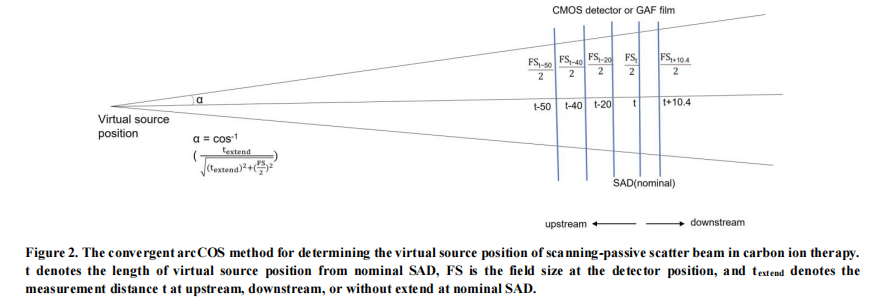
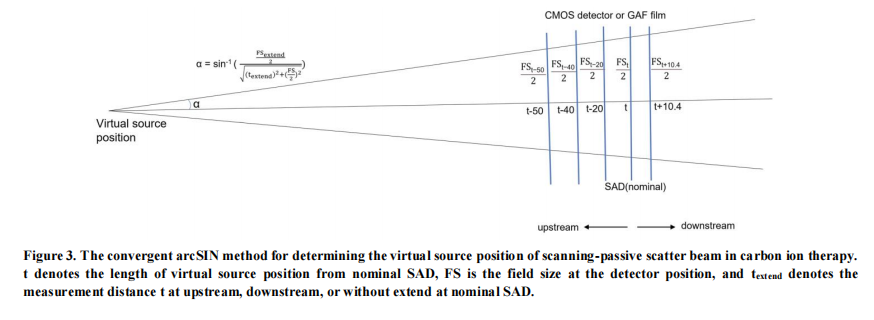
Uncertainties in the virtual source position measurements by the back projecting and convergent anti-Trigonometric Functions
The overall uncertainty in the virtual source position measurements of the specified field size measured on films is given by the alignment errors in the setup accuracy upstream or downstream from the point of SAD. Alignment errors of the films are estimated to lead to a disorder regulation of virtual source position. To archive, the accuracy of the data collection, all measurements, including the experimental setup and film processing, were repeated three times to eliminate the uncertainty caused by manual and device errors.
SPSS 20.0 was used to analyze the measurement data on films of HWFM. The measurement was expressed by mean ± SE or by percentage. The potential risk factors for the virtual source position were analyzed by using the single factor chi-square test and logistics regression model, and the difference was considered statistically significant with P<0.05.
Results
Figure 4 is the converged arcCOS method for determining the virtual source position in the horizontal direction for scanning-passive scatter in 330 MeV/u beams in carbon ion therapy.
Figure 5 is the converged arcCOS method for determining the virtual source position in the vertical direction for scanning-passive scatter in 330 MeV/u beams in carbon ion therapy.
Figure 6 is the converged arcSIN method for determining the virtual source position in the horizontal direction of scanning-passive scatter in 330 MeV/u beams in carbon ion therapy.
Figure 7 is the converged arcSIN method for determining the virtual source position in the vertical direction of scanning-passive scatter in 330 MeV/u beams in carbon ion therapy.
Figure 8 is the linear regression from the curves created by the FWHM versus nominal distance in the carbon ion energy of 330 MeV/n. (y=ax+b, y denotes FWHM, x is the virtual source distance in the film setup geometry in Figure 1).
The distance of the virtual source position of the carbon ion beam in the horizontal and vertical direction can be integrated as a function of carbon ion energy in Equations 3 and 4, respectively in Figure 9.

VSh denotes the virtual source position in the horizontal direction, E means the virtual source position at this energy of carbon ion beam.

VSv denotes the virtual source position in the vertical direction, E means the virtual source position at this energy of the carbon ion beam.
Table 1 is the FWHM of horizontal and vertical direction dose profiles measured by the large-format CMOS detectors in carbon ion therapy. Films dose profile FWHM for all carbon ion energies had been compared with CMOS, and the results were within 1.0 %.
Table 2 is the convergent arcCOS method for determining the virtual source position in the horizontal direction of scanning-passive scatter in 330 MeV/u beam in carbon ion therapy. The angle α of the arcCOS in the horizontal direction with its relative assumed virtual source position will become a unique value with all α deviation converging to a minimum value of a distance of 708 cm (with bold and underlined in Table 2) from downstream to upstream.
Table 3 is the convergent arcCOS method for determining the virtual source position in the vertical direction of scanning-passive scatter in 330 MeV/u beam in carbon ion therapy. The angle α of the arcCOS in vertical direction with its relative assumed virtual source position would become a unique value with all α deviation converging to a minimum value of a distance of 626 cm (with bold and underlined in Table 3) from downstream to upstream.
Table 4 is the convergent arcSIN method for determining the virtual source position in the horizontal direction of scanning-passive scatter in 330 MeV/u beam in carbon ion therapy.
Table 5 is the convergent arcSIN method for determining the virtual source position in the vertical direction of scanning-passive scatter in 330 MeV/u beam in carbon ion therapy.
Table 6 lists the parameters a, and b of the linear regression y=ax+b, and the virtual source position derived by back projecting the FWHM zero method and cACOS, cASIN methods for each carbon ion energy at horizontal and vertical directions.
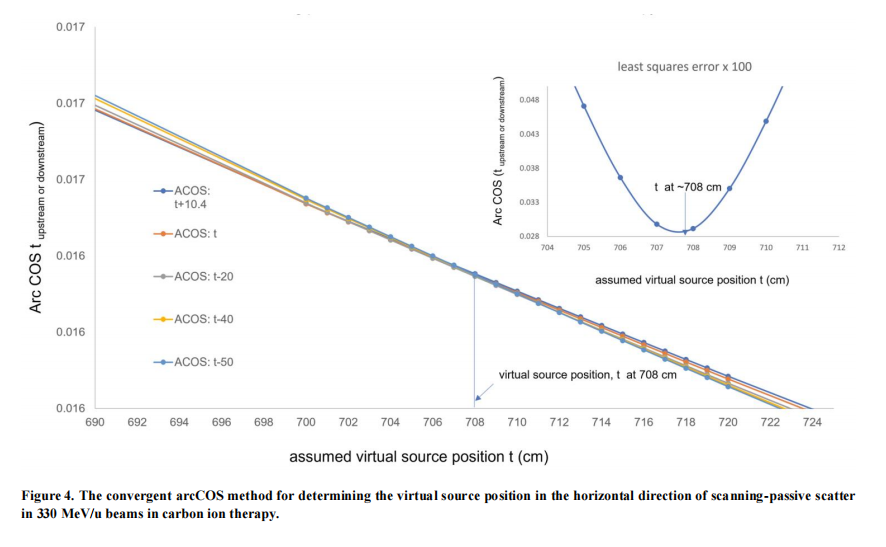
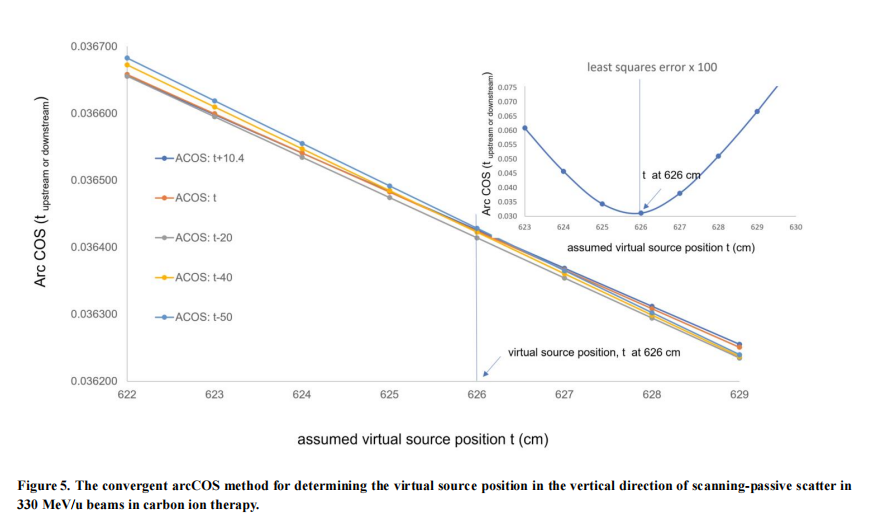
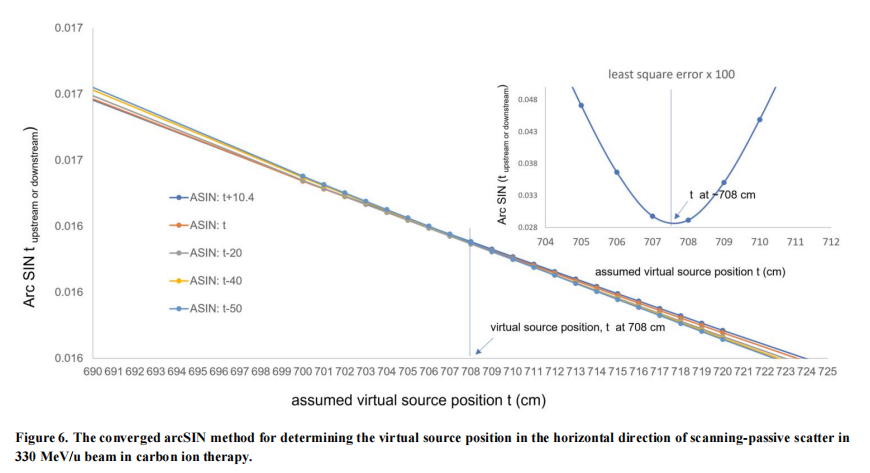
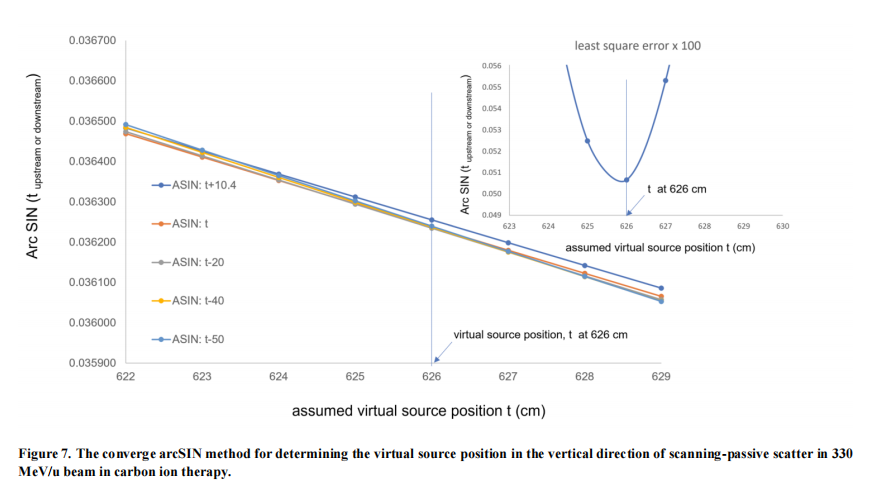
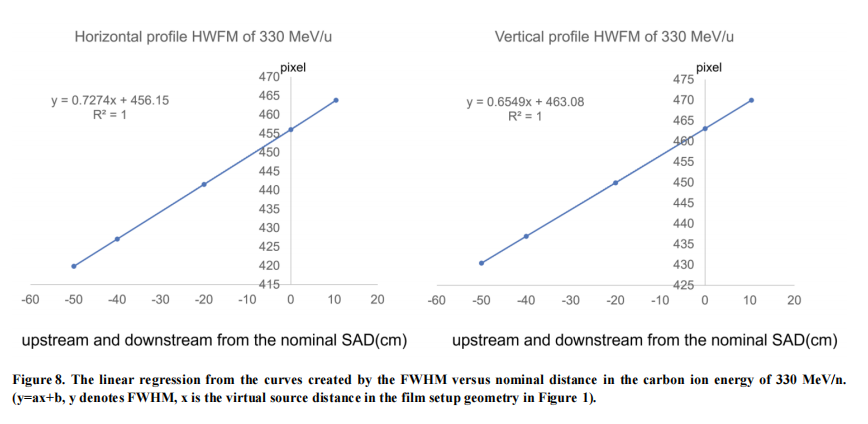
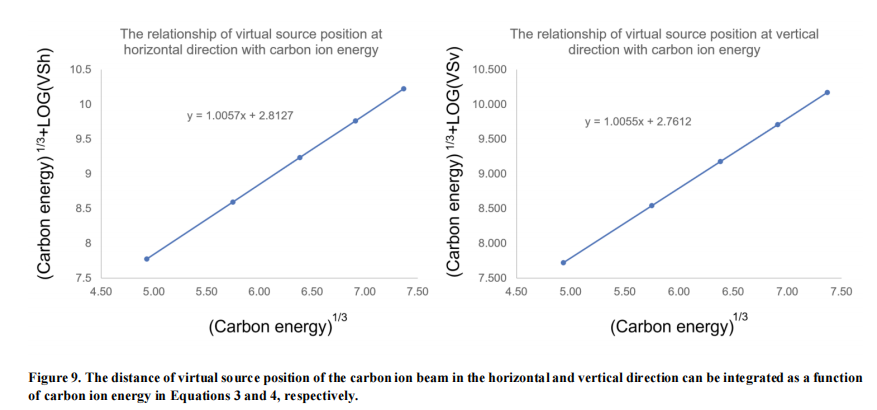

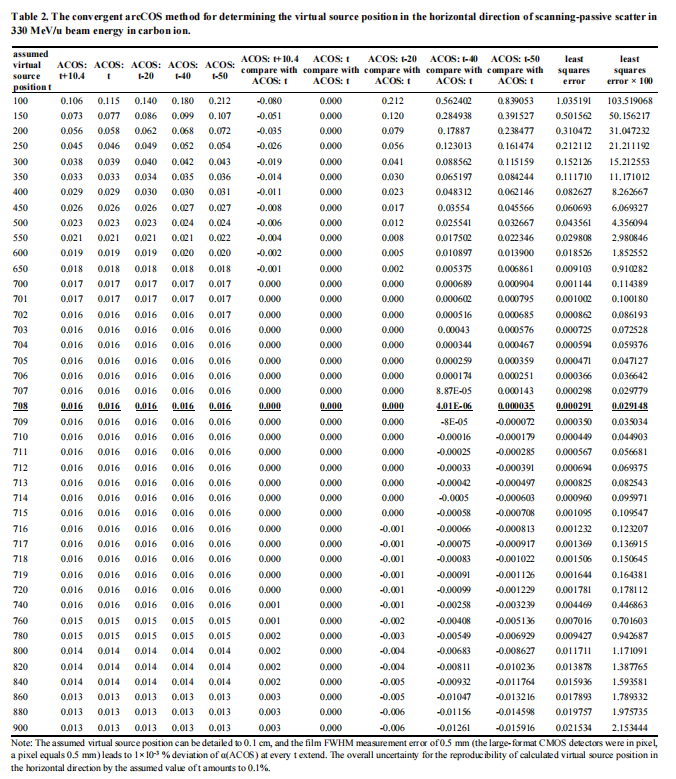
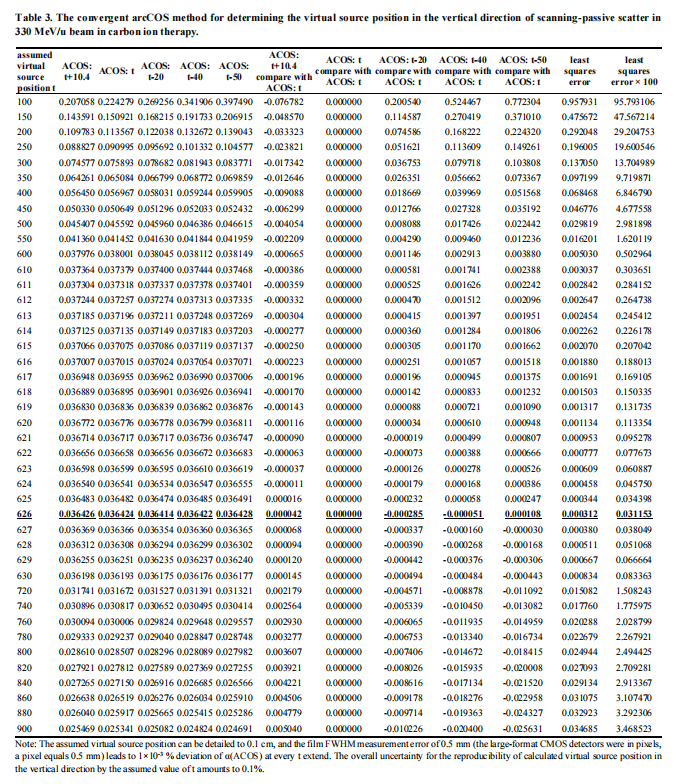
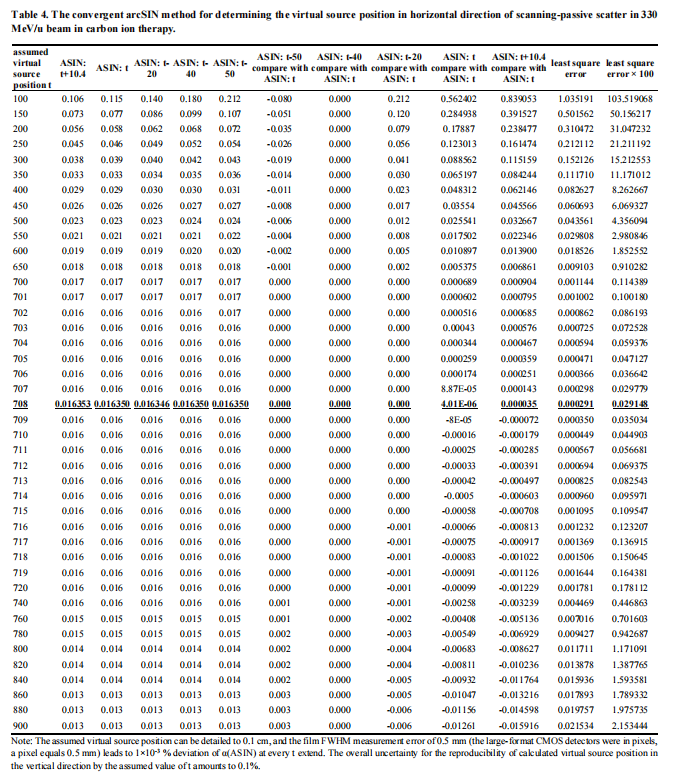
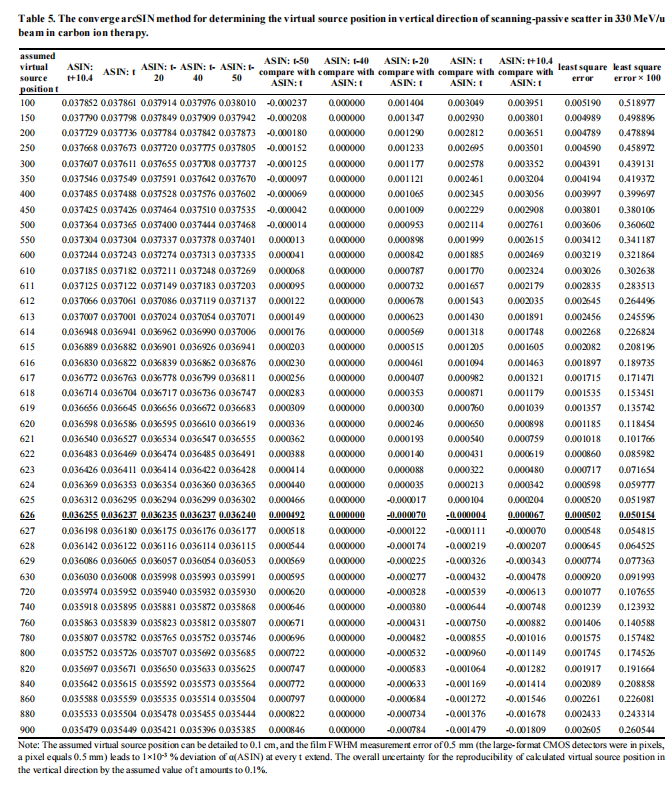

Discussion
Unlike the x-ray generated from a linear accelerator, a carbon ion beam does not emanate from a physical source in the accelerator head. The point called the virtual source of the electron beam is a pencil electron beam passing through the bending magnets, scattering foils, and monitor chambers in the head of the accelerator, and is spread into a sufficient clinical available field size that appears to diverge from a point. Measurements of the virtual source position of the electron beam can use the inverse square law method by the reading of the ion chamber to correct the dose output as a function of the air gap between the electron applicator end and the measurement position, but the inverse square law method is no longer used for carbon ion beam since the percent depth dose of the carbon ion beam is just the reverse of electron beam's percent depth dose which is well known of plateau-Bragg peak curve. There are few studies regarding the measurement of virtual source position on heavy charged particles. A cross-profile measurement of the proton fluency in the air at different positions from the isocenter was studied to determine the proton virtual source position.¹⁸ Although several methods have been suggested for the determination of virtual source position in electron beams, the virtual point source of a carbon ion beam has never been investigated and can be treated as the intersection point of the back projections along with the most probable directions of motion like electron at the film measured. The virtual source position may also be defined as a zero-field size intersection point of the FWHM back projections along with the most probable directions of the carbon ion beam where the film was measured. The field provided by the carbon ion beam in our facility in room 2 is a scanning-passive scatter type in Figure 1, which is rather than a broad beam like the electron. Thus, the virtual source point needs to be investigated separately in the horizontal (x direction) and vertical (y direction) of the beam profiles driven by horizontal and vertical magnets using the back projections of the 50% width to zero at different measurement distances.
The technique developed for carbon ion beam delivery in our facility for room 2 is scanning-passive scattering. In this approach, not like the beam that is spread using scatter foils, the delivery of scanning-passive scattering beams of our carbon ion beams was formed by thousands of narrow and quasi-monoenergetic carbon pencil-like beams magnetically by horizontal first, and then go through vertical magnets to pass a scatterer for covering a full field where the Bragg peak reach following the carbon ion energy.
The unit of FWHM in the horizontal and vertical direction in the dose profile measured by the large-format CMOS detectors was in pixels, a pixel equals 0.5 mm. Therefore, the field size of carbon ion energy 330 MeV/u at the nominal SAD was 231.53 mm (463.063 pixels × 0.5 mm) by 228.03 mm (456.063 pixels × 0.5 mm) in the horizontal and vertical directions shown in Table 1, respectively.
The value 419.11 at upstream 50 cm (-50) in the vertical direction of energy 120 MeV/u should be 419.110, while the value 441.33 at upstream 20 cm (-20) in the vertical direction of energy 190 MeV/u should be 441.330 in Table 1, respectively.
The terms "ACOS:t+10.4", et al. are explained along with Table 2 as the following. The very left column of the following Table 2 indicates the assumed virtual source position, t, this value was adopted to calculate the value of α following the definition in Materials and Methods section. The column "ACOS:t+10.4 compare with ACOS: t" means the deviation of the calculation results between (ACOS:t+10.4) and (ACOS: t) when the same assumed virtual source position, t, was given, et al. The calculation of "ACOS:t+10.4 compare with ACOS: t" is demonstrated as follows:
• (ACOS:t+10.4): t is replaced by the assumed virtual source position for calculating α, by the following equation at the distance downstream 10.4cm from the point of nominal SAD (source-axis distance)
• (ACOS: t): t is replaced by the assumed virtual source position for calculating α, by the following equation at the distance of nominal SAD (source-axis distance)
Then "ACOS:t+10.4 compare with ACOS: t" is equal to:

The meaning of the smallest least squares error indicates the actual virtual source position has been found by a given assumed virtual source position since there is only one value that can satisfy the smallest deviation with the converged angle, α, derived by the arcCOS with a given t from a distance downstream 10.4 cm and upstream 20 cm, 40 cm and 50 cm from the point of nominal SAD (source-axis distance).
The calculation of the "least squares errors" follows Equation 2 listed in the Materials and Methods section. The exact virtual source position is found when the deviation converges to the smallest value, as shown by the position of 708 cm with the smallest least square error of 0.000291 in Table 2.
The curves of different arcCOS values calculated by the assumed virtual source position in the horizontal direction, t (at nominal SAD, tupstream with upstream distances at 20 cm, 40 cm, 50 cm, and tdownstream with downstream distances at 10.4 cm) intersect at the distance of 708 cm, which is the minimum least squares error of all converged angle, α, calculated by the arcCOS demonstrated in the small figure at upper right in Figure 4. This point demonstrates the determination of virtual source position by the arcCOS convergent method in the horizontal direction of scanning-passive scatter for 330 MeV/u beam energy, and similarly for other carbon ion energies. A smaller value than 708 cm for the virtual source position in the small figure in the upper right in Figure 4 suggests that decreasing the scale of the assumed virtual source position leads to a more precise result.
The detailed process of the convergent arcCOS method for determining the virtual source position in the horizontal direction of scanning-passive scatter beam in 330 MeV/u carbon ion therapy is listed in Table 2. The least squares error, 0.00029148, occurs at the assumed virtual source position, t, at 708 cm (with bold and underlined) in Table 2 and Figure 4.
The curves of different arcCOS values calculated by the assumed virtual source position in the vertical direction, t (at nominal SAD, tupstream with upstream distances at 20 cm, 40 cm, 50 cm, and tdownstream with downstream distances at 10.4 cm) intersect at the distance of 627 cm, which is the minimum least squares error of all converged angle, α, calculated by arcCOS demonstrated in the small figure at upper right in Table 3 and Figure 5. This point demonstrates the determination of the virtual source position in the vertical direction of scanning-passive scatter for 330 MeV/u beam energy, and similarly for other carbon ion energies.
The detailed process of the convergent arcSIN method for determining the virtual source position in the horizontal direction of scanning-passive scatter beam in 330 MeV/u carbon ion therapy is listed in Table 4. The least squares error, 0.029148 (with bold and underlined), occurs at the assumed virtual source position, t, at 708 cm in Table 4 and Figure 6.
The curves of different arcSIN values calculated by the assumed virtual source position in the vertical direction, t (at nominal SAD, tupstream with upstream distances at 20 cm, 40 cm, 50 cm, and tdownstream with downstream distances at 10.4 cm) intersect at the distance of 627 cm, which is the minimum least squares error of all converged angle, α, calculated by arcSIN demonstrated in the small figure at upper right in Table 5 and Figure 7. This point demonstrates the determination of the virtual source position in the vertical direction of scanning-passive scatter for 330 MeV/u beam energy, and similarly for other carbon ion energies.
The detailed process of the convergent arcSIN method for determining the virtual source position in the vertical direction of scanning-passive scatter beam in 330 MeV/u carbon ion therapy is listed in Table 5. The least squares error, 0.050154 (100 times of original value, with bold and underlined), occurs at the assumed virtual source position, t, at 626 cm in Table 5.
Figure 8 demonstrates the linear regression from the curves created by the FWHM versus the nominal distance in the carbon ion energy of 330 MeV/n. (y=ax+b, y denotes FWHM, x is the virtual source distance in the film setup geometry in Figure 1), and similarly for the determination of the virtual source position in other carbon ion energies listed in Table 6.
Table 6 shows the parameters a and b in the linear regression when y=0 (y denotes field size in y=ax+b), which means the virtual source position, x, occurs at the back projection point when the field size becomes zero. The virtual source position derived by the cACOS and cASIN methods is also listed in Table 6 for comparison with results derived by back-projecting HWFM to zero methods.
The solution of x in y=ax+b (parameters a and b) is listed in Table 4, generated by the same process of back projecting HWFM to zero methods to get the virtual source position for every energy.
Mathematically, when the velocity of the particle v is perpendicular to the direction of the magnetic field, we can write F=q(V×B). Hence, higher carbon ion energy (higher velocity) leads to a stronger force bending the carbon ion by the horizontal and vertical magnets. Therefore, the distance of virtual source positions increases from SAD with high to low energy, as shown in Table 6.
The distance of the virtual source position of the carbon ion beam in the horizontal and vertical direction can be integrated as a function of carbon ion energy in Equations 3 and 4 in Figure 9, respectively. The virtual source position in the horizontal direction is presented by VSh (Equation 3) and VSv (Equation 4). The relationship of virtual source position and carbon ion energy in horizontal and vertical directions generated in Equations 3 and 4 shows that calculations and measurements agree within 1%.
The MLC opening, as well as the fabrication of the compensator, were then corrected according to the measured virtual source position for every carbon ion energy in the horizontal and vertical directions. Furthermore, the MLC opening depends not only on the accuracy of the virtual source position but also depends on whether the MLC offset is carefully adjusted.¹⁹
Conclusion
The study regarding virtual source position in carbon ion is none, and we have developed a technique capable of dealing with the virtual source position with convergent arcCOS and arcSIN methods to avoid any mistakes in scanning-passive scatter carbon ion beam in our facility. The method for investigating the virtual source position in a carbon ion beam in this study can be applied to the external electron beam and the proton beam. The importance of precise virtual source position in the Monte Carlo simulation is indispensable. The calculation of radiation doses may not always be in agreement for MLC treatment fields at a carbon ion beam treatment planning system unless the virtual source position and MLC offset are well-calibrated. The current method does not model effects from the MLC thickness, nor of the compensator's scattering. However, expansion of this method to incorporate these effects as well as in pencil scanning beam is possible and is currently being worked on.
Acknowledgements
The author appreciates Professor Wen-Hua Zhang, and Professor Jian Wang for their great contribution to this study. Professor Jian Wang is juxtaposed with the co-first author (co-first authors with equal contribution). Professor Wen-Hua Zhang is juxtaposed with the correspondence author (co-corresponding authors with equal contribution).
This work was supported by the Funding: Central government Guided Local fund projects of the Science and Technology Department of Gansu Province, China. (The Precise therapy platform of clinical and research for radiation oncology in carbon ion therapy 22ZY1QH001).
This work was supported by the Funding: Key R&D plan of the Science and Technology Program of Gansu Province, China. (19YF3FH001).
Competing interests.
There are no actual or potential competing interests in this study. This manuscript has not been published nor concurrently submitted for publication elsewhere.
The MLC opening, as well as the fabrication of the compensator, were then corrected according to the measured virtual source position for every carbon ion energy in the horizontal and vertical directions. Furthermore, the MLC opening depends not only on the accuracy of the virtual source position but also depends on whether the MLC offset is carefully adjusted.¹⁹
References
- Sawkey DL, Faddegon BA. Determination of electron energy, spectral width, and beam divergence at the exit window for clinical megavoltage x-ray beams. Med Phys. 2009;36:698-707.
- Sham E, Seuntjens J, Devic S, Podgorsak EB. Influence of focal spot on characteristics of very small diameter radiosurgical beams. Med Phys. 2008;35(7):3317-3330.
- Knöös T, Wieslander E, Cozzi L, et al. Comparison of dose calculation algorithms for treatment planning in external photon beam therapy for clinical situation. Phys Med Biol. 2006;51(22):5785-5807.
- Sterpin E, Tomsej M, De Smedt B, et al. Monte Carlo evaluation of the AAA treatment planning algorithm in a heterogeneous multilayer phantom and IMRT clinical treatments for an Elekta SL25 linear accelerator. Med Phys. 2007;34(5):1665-1677.
- Bortfeld T, Schlegel W. An analytical approximation of depth–dose distributions for therapeutic proton beams. Phys Med Biol. 2007;41(8):1331-1339.
- Chetty IJ, Curran B, Cygler JE, et al. Report of the AAPM Task Group No. 105: Issues associated with clinical implementation of Monte Carlo-based photon and electron external beam treatment planning. Med Phys. 2007;34(12):4818-4853.
- Kooy H, Rosenthal S, Engelsman M, et al. The prediction of output factors for spread-out proton Bragg peak fields in clinical practice. Phys Med Biol. 2005;50(24):5847-5856.
- Kooy H, Schaefer M, Rosenthal S, Bortfeld T. Monitor unit calculations for range-modulated spread-out Bragg peak fields. Phys Med Biol. 2003;48(17):2797-2808.
- Petti PL. Differential-pencil-beam dose calculation for charged particles. Med Phys. 1992;19:137-149.
- Verhaegen F, Seuntjens J. Monte Carlo modeling of external radiotherapy photon beams. Phys Med Biol. 2003;48(21):R107-R164.
- Russell KR, Isacsson U, Saxner M, et al. Implementation of pencil kernel and depth penetration algorithms for treatment planning of proton beams. Phys Med Biol. 2000;45(1):9-27.
- Reynaert N, van der Marck SC, Schaart DR, et al. Monte Carlo treatment planning for photon and electron beams. Radiat Phys Chem. 2007;76(4):643-686.
- Lei KM, Mak PI, Law MK, Martins RP. CMOS biosensors for in vitro diagnosis - transducing mechanisms and applications. Lab Chip. 2016;16(19):3664-3681.
- Kang HG, Song JJ, Lee K et al. An investigation of medical radiation detection using CMOS image sensors in smartphones. Nuclear Inst and Methods in Physics Research, A. 2016;823:126-134.
- Dreindl R, Georg D, Stock M. Radiochromic film dosimetry: considerations on precision and accuracy for EBT2 and EBT3 type films. Zeitschrift für Medizinische Physik. 2014;24(2):153-163.
- Kamomae T, Miyabe Y, Sawada A, et al. Simulation for improvement of system sensitivity of radiochromic film dosimetry with different band-pass filters and scanner light intensities. Radiol Phys Technol. 2011;4(2):140-147.
- García-Garduño OA, Lárraga-Gutiérrez JM, Rodríguez-Villafuerte M, et al. Effect of correction methods of radiochromic EBT2 films on the accuracy of IMRT QA. App Radi Isot. 2016;107:121-126.
- Schaffner B. Proton dose calculation based on in-air fluence measurements. Phys Med Biol. 2008;53(6):1545-1562.
- Wu JM, Lee TF, Kuo CM. A light field-based method to adjust rounded leaf end MLC position for split shape dose calculation correction in a radiation therapy treatment planning system. J Appl Clin Med Phys. 2012;13(6):3937.
Preliminary Review: Zhang Jie Final Review: Zhang Lihong
